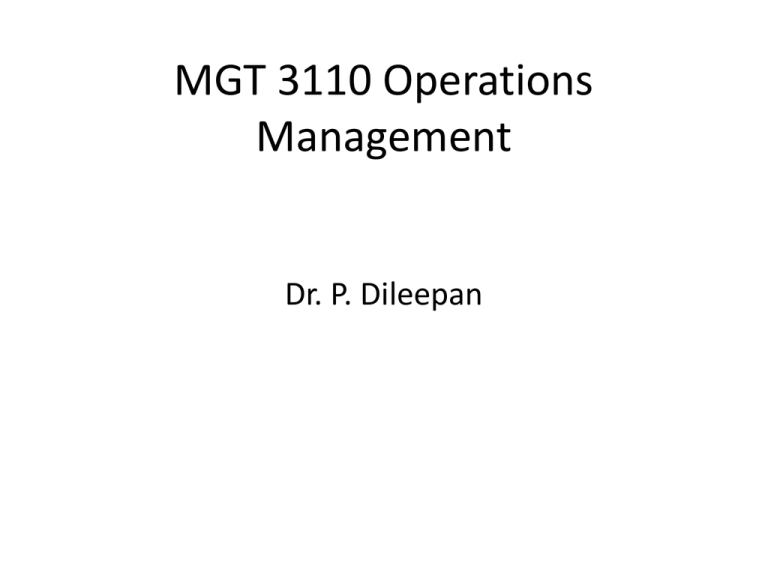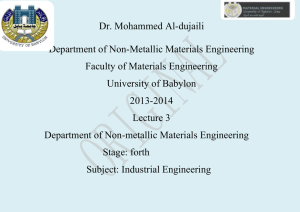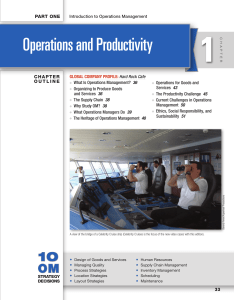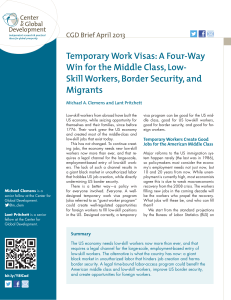
MGT 3110 Operations
Management
Dr. P. Dileepan
Chapter 1
Introduction to Operations
Management
McGraw-Hill/Irwin
Copyright © 2012 by The McGraw-Hill Companies, Inc. All rights reserved.
Chapter 1: Learning Objectives
You should be able to:
1. Define the term operations management
2. Identify the three major functional areas of organizations and describe how they
interrelate
3. Identify similarities and differences between production and service operations
4. Describe the operations function and the nature of the operations manager’s job
5. Summarize the two major aspects of process management
6. Briefly describe the historical evolution of operations management
7. Characterize current trends in business that impact operations management
8. Define the term productivity and explain why it is important to organizations and
countries
9. Provide some reasons for poor productivity and some ways of improving it
Operations Management
• What is operations?
– The part of a business organization that is
responsible for producing goods or services
• How can we define operations management?
– The management of systems or processes that
create goods and/or provide services
1-4
Basic Functions of the Business Organization
Organization
Marketing
Operations
Finance
1-5
The Transformation Process
Value-Added
Inputs
•Land
•Labor
•Capital
•Information
Transformation/
Conversion
Process
Outputs
•Goods
•Services
Measurement
and Feedback
Measurement
and Feedback
Control
Measurement
and Feedback
Feedback = measurements taken at various points in the transformation process
Control = The comparison of feedback against previously established
standards to determine if corrective action is needed.
1-6
Supply Chain
Supply Chain – a sequence of activities and
organizations involved in producing and delivering
a good or service
Suppliers’
suppliers
Direct
suppliers
Producer
Distributor
Final
Customers
1-7
Supply Chain for Bread
1-8
Good or Service?
Goods are physical items that include raw materials, parts,
subassemblies, and final products.
•Automobile
•Computer
•Oven
•Shampoo
Services are activities that provide some combination of time, location,
form or psychological value.
•Air travel
•Education
•Haircut
•Legal counsel
1-9
Goods-service Continuum
Products are typically neither purely service- or purely goodsbased.
Goods
Services
Surgery, Teaching
Songwriting, Software Development
Computer Repair, Restaurant Meal
Home Remodeling, Retail Sales
Automobile Assembly, Steelmaking
1-10
Manufacturing vs. Service?
Manufacturing and Service Organizations differ chiefly because
manufacturing is goods-oriented and service is act-oriented.
Goods
Services
Tangible
Act-Oriented
1-11
Manufacturing vs. Service
1. Degree of customer contact
2. Uniformity of input
3. Labor content of jobs
4. Uniformity of output
5. Measurement of productivity
6. Production and delivery
7. Quality assurance
8. Amount of inventory
9. Evaluation of work
10.Ability to patent design
1-12
Managing Services is Challenging
1.
2.
3.
4.
5.
6.
7.
Jobs in services are often less structured than in manufacturing
Customer contact is generally much higher in services compared to
manufacturing
In many services, worker skill levels are low compared to those of
manufacturing employees
Services are adding many new workers in low-skill, entry-level positions
Employee turnover is high in services, especially in low-skill jobs
Input variability tends to be higher in many service environments than in
manufacturing
Service performance can be adversely affected by many factors outside of the
manager’s control (e.g., employee and customer attitudes)
1-13
Scope of Operations
Management
The scope of operations management ranges across
the organization.
The operations function includes many interrelated activities
such as:
Forecasting
Capacity planning
Facilities and layout
Scheduling
Managing inventories
Assuring quality
Motivating employees
Deciding where to locate facilities
And more . . .
1-14
Role of the Operations Manager
The Operations Function consists of all activities directly related
to producing goods or providing services.
A primary function of the operations manager is to guide the
system by decision making.
– System Design Decisions
– System Operation Decisions
1-15
System Design Decisions
• System Design
– Capacity
– Facility location
– Facility layout
– Product and service planning
– Acquisition and placement of equipment
• These are typically strategic decisions that
• usually require long-term commitment of resources
• determine parameters of system operation
1-16
System Operation Decisions
• System Operation
• These are generally tactical and operational decisions
– Management of personnel
– Inventory management and control
– Scheduling
– Project management
– Quality assurance
• Operations managers spend more time on system operation
decision than any other decision area
• They still have a vital stake in system design
1-17
Decision Making
Most operations decisions involve many alternatives that can have quite
different impacts on costs or profits
Typical operations decisions include:
What: What resources are needed, and in what amounts?
When: When will each resource be needed? When should the work be
scheduled? When should materials and other supplies be ordered?
Where: Where will the work be done?
How: How will he product or service be designed? How will the work be
done? How will resources be allocated?
Who: Who will do the work?
1-18
Historical Evolution of OM
•
•
•
•
•
Industrial Revolution
Scientific Management
Human Relations Movement
Decision Models and Management Science
Influence of Japanese Manufacturers
1-19
Industrial Revolution
• Pre-Industrial Revolution
– Craft production - System in which highly skilled workers use simple, flexible
tools to produce small quantities of customized goods
• Some key elements of the industrial revolution
–
–
–
–
Began in England in the 1770s
Division of labor - Adam Smith, 1776
Application of the “rotative” steam engine, 1780s
Cotton Gin and Interchangeable parts - Eli Whitney, 1792
• Management theory and practice did not advance appreciably during
this period
1-20
Scientific Management
• Movement was led by efficiency engineer, Frederick Winslow
Taylor
– Believed in a “science of management” based on observation,
measurement, analysis and improvement of work methods, and
economic incentives
– Management is responsible for planning, carefully selecting and
training workers, finding the best way to perform each job, achieving
cooperate between management and workers, and separating
management activities from work activities
– Emphasis was on maximizing output
1-21
Scientific Management - contributors
• Frank Gilbreth - father of motion studies
• Henry Gantt - developed the Gantt chart scheduling system
and recognized the value of non-monetary rewards for
motivating employees
• Harrington Emerson - applied Taylor’s ideas to organization
structure
• Henry Ford - employed scientific management techniques to
his factories
• Moving assembly line
• Mass production
1-22
Human Relations Movement
• The human relations movement emphasized the
importance of the human element in job design
– Lillian Gilbreth
– Elton Mayo – Hawthorne studies on worker motivation, 1930
– Abraham Maslow – motivation theory, 1940s; hierarchy of needs,
1954
– Frederick Hertzberg – Two Factor Theory, 1959
– Douglas McGregor – Theory X and Theory Y, 1960s
– William Ouchi – Theory Z, 1981
1-23
Decision Models & Management
Science
• F.W. Harris – mathematical model for inventory management, 1915
• Dodge, Romig, and Shewart – statistical procedures for sampling and
quality control, 1930s
• Tippett – statistical sampling theory, 1935
• Operations Research (OR) Groups – OR applications in warfare
• George Dantzig – linear programming, 1947
1-24
Influence of Japanese Manufacturers
• Refined and developed management practices that increased
productivity
– Credited with fueling the “quality revolution
– Just-in-Time production
1-25
Key Issues for Operations
Managers Today
•
•
•
•
•
Economic conditions
Innovating
Quality problems
Risk management
Competing in a global economy
1-26
Ethical Issues in Operations
• Ethical issues arise in many
aspects of operations
management:
Financial statements
Worker safety
Product safety
Quality
The environment
The community
Hiring and firing workers
Closing facilities
Workers rights
1-27
Productivity
Units produced
Productivity =
Input used
• Productivity
– A measure of the effective use of resources,
usually expressed as the ratio of output to input
2-28
Partial Productivity Measures
Single-factor productivity =
Units produced
Single input used
Labor productivity =
Units produced
Labor-hours used
Capital productivity =
Units produced
Capital used
2-29
Multifactor Productivity
Multifactor Productivity =
Output
Labor + Material + Energy +
Capital + Miscellaneous
Total Productivity =
Output
Sum of all the inputs
Productivity Calculation Example
Units produced: 5,000
Standard price: $30/unit
Labor input:
500 hours
Cost of labor: $25/hour
Cost of materials:
$5,000
Cost of overhead:
2x labor cost
What is the multifactor productivity?
2-31
Solution
Multifactor Productivity
=
Output
Labor +Material +Overhead
=
5,000 units $30/unit
(500 hours $25/hour) + $5,000 + (2(500 hours $25/hour))
=
$150,000
$42,500
= 3.5294
2-32
Productivity Growth
Productivity Growth
=
Current productivity - Previous productivity
100%
Previous productivity
Example: Labor productivity on the ABC assembly line was 25 units per
hour in 2009. In 2010, labor productivity was 23 units per hour. What was
the productivity growth from 2009 to 2010?
Productivity Growth
=
23 - 25
100% 8%
25
2-33
Service Sector Productivity
Service sector productivity is difficult to measure and
manage because
It involves intellectual activities
It has a high degree of variability
A useful measure related to productivity is process yield
Where products are involved
ratio of output of good product to the quantity of raw material
input.
Where services are involved, process yield measurement is
often dependent on the particular process:
ratio of cars rented to cars available for a given day
ratio of student acceptances to the total number of students
approved for admission.
2-34
Factors Affecting Productivity
Methods
Capital
Technology
Quality
Management
2-35
Improving Productivity
1.
Develop productivity measures for all operations
2.
Determine critical (bottleneck) operations
3.
Develop methods for productivity improvements
4.
Establish reasonable goals
5.
Make it clear that management supports and encourages productivity
improvement
6.
Measure and publicize improvements
Don’t confuse productivity with efficiency
2-36












